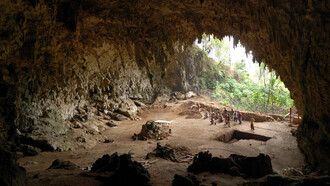Vietnamese artist, Tiffany Chung’s eye-catching artwork explicitly and implicitly create a dialogue on urbanisation as a process due to globalisation and within the world-system. Her area-specific artworks on Ho Chi Minh City (HCMC) elucidate upon human mentality manifested into action and the spheres of control employed in the urbanisation process through the power of aesthetics and the manipulation of spatial history and significance.
Tiffany Chung’s maps explore major socio-political and environmental issues that have affected specific cities such as internal and external conflict, natural disaster, and urban progress. Her maps on urbanisation in HCMC primarily target the Thu Thiem Urban Zone under construction, referencing the area’s historical and current mapping as well as the future visualisations and the ecological changes as part of the process. While extensively researching her topics, Chung also places great emphasis on the aesthetics of the pieces by using brilliant colours of nearly undulating circles and dots, and at times enhancing the intricacy with thread, tacs, and grommets.
The artist has admitted that many consider her maps to be a “trap” attracting people by their beauty and subsequently forcing viewers to confront the social, historical, political, and psychological issue(s) presented. In this attribute of entrapment, the maps surpass simple presentation of issues and adopt further (perhaps inadvertent) tangibility to her topic of the urban process in HCMC. The Thu Thiem project is going forth on the once densely populated area, but as one of the poorer neighbourhoods in HCMC, it was considered a slum and visually unappealing.
The Thu Thiem project will replace the poor shacks and construct a new modern city image. As the capital city, Hanoi holds the position as cultural centre placing importance on traditional architecture. HCMC, conversely, is distinguished as the industrial, modern face of the nation, which is a predominant factor in the formation of the urban aesthetic in the rapidly developing city. Chung’s maps project the power and pull of the visual, or aesthetic, on the actions and psychology of both the political society and civil society. Like viewers of her work, participants, both active and passive (or those who affect and those who are affected), in the urban process are influenced by the prospect of the aesthetic, and their actions are thus motivated by their perception of its merits.
The visual environment and the symbolism within it can heavily influence decisions and encourage certain perceptions of an urban city. The power of the aesthetic can be manipulated through Gramcian theories of top-down (political society) and bottom-up processes (civil society), and it is the blend of these two elements that has the clandestine power to mould and persuade the minds of the public so drastically. A map is a historically specifically powerful tool for (re)structuring an understanding of place and self, one which creates binaries and false histories. Chung’s maps, in a sense, imitate the early colonial maps, which chronicled the areas historically, writing a national narrative. By employing similar tactics of spatially showing chronological change through maps, the artist’s work reflects the narrative creating abilities and begins a “cartographic discourse”. Viewed as art, maps produce the opposite effect of the originals by calling the narrative of the area represented into question rather than promoting the storyline. This forces critical thought on the legitimacy of the perceptions of the space. Her use of colour is also reminiscent of the historical map, but whereas the old maps’ use of colour divided areas like a “jigsaw”, Chung’s have been called “fungal” and draw a parallel to the agendas of the master plans functioning, at times, at the expense of that which already inhabits the space.
Showing the various viewpoints from which maps are created, Chung at times layers maps depicting different time periods to show the incongruity in what Henri Lefebvre calls “absolute space”. Her maps representing the future of Thu Thiem mimic the developer’s (Sasaki) own maps and use the duality to solidify the idea of the symbolic and physical area as moulded by whatever human projection has momentary control.
In Chung’s maps, urbanisation planning and implementations are the physical manifestation of the issue of reconstruction of site and history, placing the built environment at focus in the broader issue of ideology and spatial-historical manipulation and control. And with the world lacking true empirical qualities, values manifest themselves into “imagined worlds”, distinct to each individual. This simultaneous yet inharmonious amalgamation of perceived truths provide the base for Chung’s maps and their efforts to question these notions of reality, especially those provided or supported by the state. Her presentation of aesthetically distinct maps showing multiple perspectives of a singular absolute space coming from varied times and viewpoints brings forth the question of objectivity of the image and historicity of the city.
Manipulation of mentality through space and the built environment has such a deep impact both locally and globally. Tiffany Chung’s spellbinding artwork appropriates the traditional nation-building technique of the map to call attention to both historical and contemporary practices of overt and covert persuasion. A jarring realization to be faced with, viewers are presented with their role in their own destruction. The brilliant colouring and gorgeous visual of the artist’s work serves to even more deeply elaborate on the ease and comfort with which we do so.
This article is part of a larger academic paper: Repainting the Body and Mind of Ho Chi Minh City: Exploring Urbanisation in the Global World-System through the Artistic Practice. (2016)














